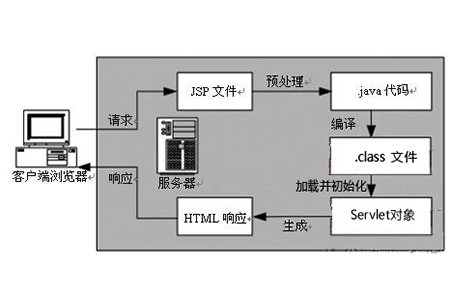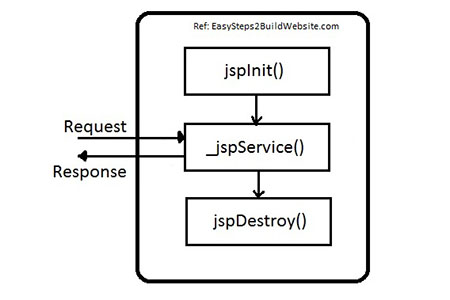
The life cycle of a JSP file is divided into seven stages: parsing, compilation, class loading, instantiation, initialization, request processing, and destruction.
JSP files are saved with a .jsp extension, which allows the server to know that this is a JSP file and needs to go through several JSP life cycle stages. This article introduces the life cycle of JSP and gives you a preliminary understanding of the life cycle of JSP files. I hope it will be helpful to you. [Recommended related video tutorials: JSP Tutorial]

Let’s take a closer look at each stage of the life cycle of a JSP file. What it does:
1. JSP file parsing (preprocessing) phase
When the client makes a request to the Server (server), the JSP file will first be transferred to the servlet container; then It is parsed in the servlet container and converted into a Servlet source file (.java file)
2. Compilation phase
Compiles the servlet source file (.java file) in the servlet container to generate a servlet class (.CLASS file)

## JSP overall execution flow diagram
3, class loading phase
## class loader loading class file, container, container, container, container, container, container, container Will check if the servlet class is older than the jsp file (make sure the JSP file has been modified). If the JSP file is modified, then the container will perform the conversion (convert JSP to Servlet) again, otherwise it will skip the conversion stage (i.e. if the JSP web page has not been modified, then it will not perform the conversion to Improve performance as this phase takes time). 4. Instantiation phaseCreate the object that generates the Servlet and instantiate the servlet class5. Initialization phaseAfter loading the JSP file, The container will call the jspInit() method to initialize the servlet instance before providing any services for the request (the Jsp container will only execute this stage if the instance of the servlet file is not running or it is older than the jsp file.)public void jspInit(){
// 初始化代码
}void _jspService(HttpServletRequest req,HttpServletResponse res)
{
// 代码
}public void jspDestory()
{
//删除servlet类实例的代码
}
The above is the detailed content of The life cycle of a JSP file is divided into several stages. For more information, please follow other related articles on the PHP Chinese website!


